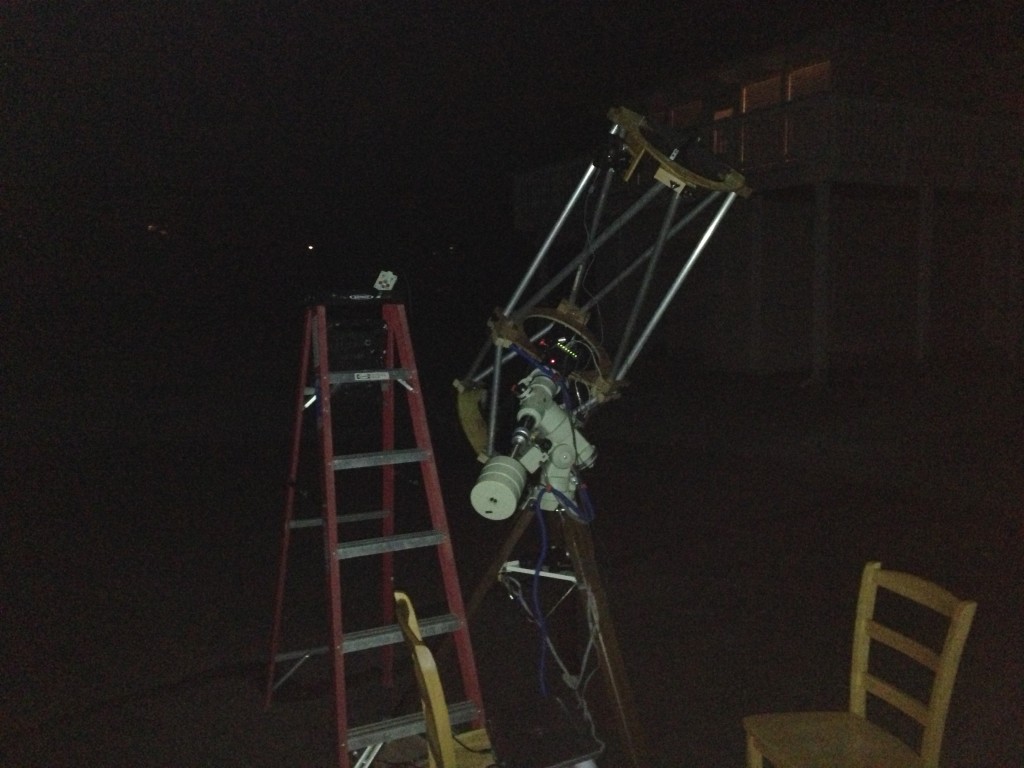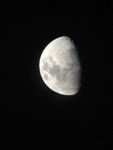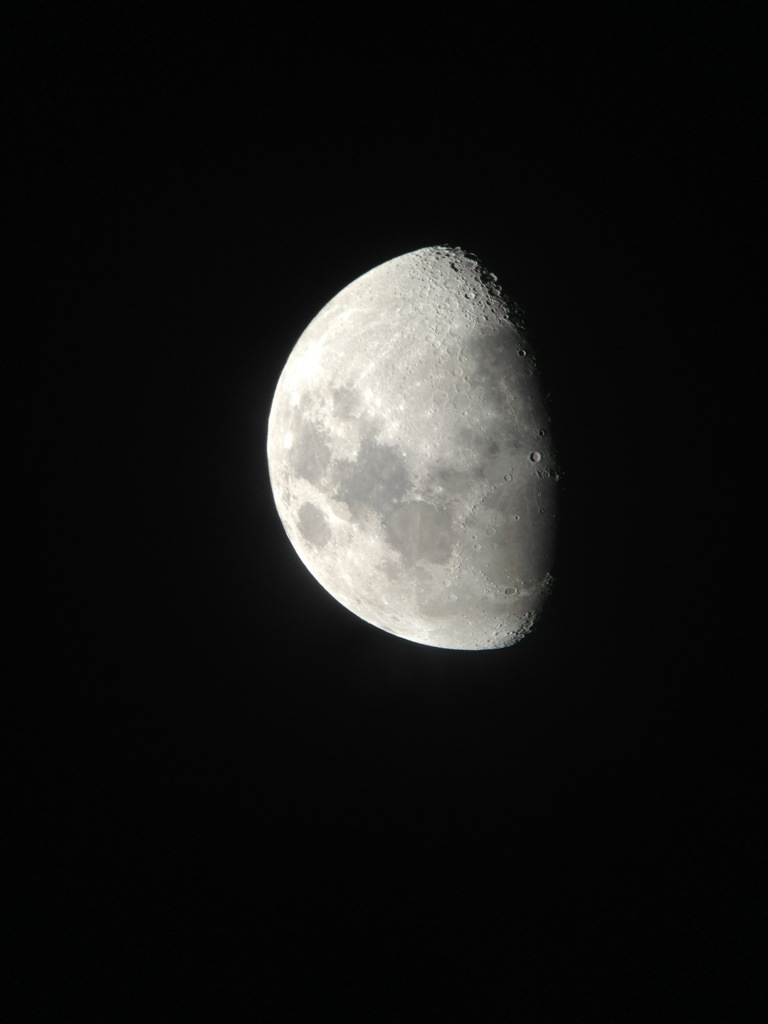It was a gorgeous sunny day today in Seattle (very strange for mid February), and the clear skies held up until nearly 11pm.
Kismet or dumb luck, I knew that this was the night to give Trixie some room to run.

Man, that is one big scope. I took the scope and mount out in 2 trips; if it was easier to get the CW shaft on and off, I’d have done 3 instead. I fear stripping the CW shaft attachment, though, so I left all the weight on.
Polar alignment is a little more challenging with counterweights. I got it done, but every movement needs to be a little more deliberate, because it feels like you’re in constant danger of just tipping the whole thing over on its side.
Once the mount was aligned, I put on the OTA, during which I bumped the mount (of course), so I had to refine the alignment again. The polar scope reticle really does make it pretty easy.
I started with just a quick visual tour; in went the 32mm eyepiece, and I pointed at the moon. I had the mount plugged in so that I could keep the RA motor running, but I wasn’t using any other electronics. I checked out the moon, M42, Jupiter, and M45 at the eyepiece. I’m still blown away by how much detail the scope picks up in faint objects like M42. I could nearly see the “head” of the nebula, and there was just a ton of detail in the wispy clouds.
The moon was, simply, gorgeous.
This photo took me back to my roots a bit — it was taken afocally, pointing my iPhone at the image in the eyepiece, the same way I captured my first astrophoto, nearly 9 years ago to the day. It’s obviously had no other treatment — I didn’t even rotate it around so north is up.
I took the time to align the finder and main scope (roughly), and decided to try some planetary photography. I hooked up the NexImage, got it running in Craterlets (which took a bit of fiddling — I’m very rusty), and tweaked the settings until I could get a more or less focused image. With the 2x Barlow, I was getting individual crater shots. I cruised around on the moon for awhile, then swung over to Jupiter, where I admit I spent the bulk of my time (and disk space) tonight.
I spent a long time playing with the settings, first overexposing so I could attempt to focus, then tweaking the exposure length to try to make the planet look right. I got everything all set up, then tried to do an imaging run, and Craterlets changed all my settings. It’s very irritating. I am sure that I just had it set up incorrectly or something, but I couldn’t get it to do what I wanted, so I switched to K3CCDTools, my old standby for planetary imaging. At one point, I attempted to add the Klee 2.8x Barlow to the mix, but that was just adding a level of complication I wasn’t in the mood for.
Even with “just” the 2x Barlow in place, Jupiter was making a pretty big image on the screen, and I was amazed at how bright it was! I was able to shoot at 30fps, and even had the exposure time cranked back a little (I got it as fast as 1/150sec before I had to move the gain up to 75%). There is a lot of light coming into the scope.
I shot a couple of AVIs of Jupiter, but I can tell that the collimation is pretty soft right now — Jupiter’s moon looked like a little coma instead of a ball. I also have the manual focuser on, so focus is a little touchy.
There was a lot of vibration as I touched the focuser; I remember that being a very delicate operation on Veronica, too, but it remains to be seen whether it’s “too” touchy on Trixie. I was testing a lot of different things at once tonight, but definitely one of the main things is how Trixie is performing on the mount, and whether I think she’ll make a good astrograph. The jury’s obviously still out, but I got a lot of good information tonight.
With a couple of AVIs on the disk, I decided to try getting the Canon working again. I got it all put together, got it in the focuser, slewed back to the moon, and tried to get it to focus… clank. I ran out of backfocus! I vaguely remember this from the last time I’d had Trixie out, and I believe I pushed the primary pretty far forward to fix the problem. Well, it’s there again. I didn’t realize until after I’d gotten the scope back inside that Art had collimated the scope, and he probably wasn’t paying attention to backfocus at the time. That’s cool — I just need to do a good solid collimation run on the scope before we go back outside.
Anyway, I found that if I got the camera shoved all the way down, where the T-ring was touching the focuser (meaning that the undercut on the barrel was riding improperly on the compression ring), I could get close enough to focus to make it work.
I booted up MaxIM and tried connecting, and that took a bit of work — I needed the mount to be connected to Cartes du Ciel as well, and I plugged in the guidescope too, just in case… and I *still* had to turn off the DSUSB (and disable mirror lockup) in order to get the shutter to fire. I ran a series of snapshots of the moon with the DSLR, and we’ll see how those turn out. I can’t get the camera to go “past” focus, so I don’t know if I actually got to focus, or if I still need more backfocus. Once I collimate, I’ll test it again.
The secondary started to dew up (although the primary stayed surprisingly clear), about the same time as the sky went from “clear” to “suckerhole”. I decided it was time to pack it in for the night.
I have some processing to do, it will be interesting to see if I got anything useful.
I sure am impressed by the scope. It’s a big difference over Veronica as far as light gathering. Good job, Trixie! Suddenly, I’m back in “maintenance” mode instead of “build” mode.




So when do we start building the observatory complex?
The sooner, the better. That scope, as awesome an instrument as it is, is not easy to lift. Here’s to a cubic yard of concrete!